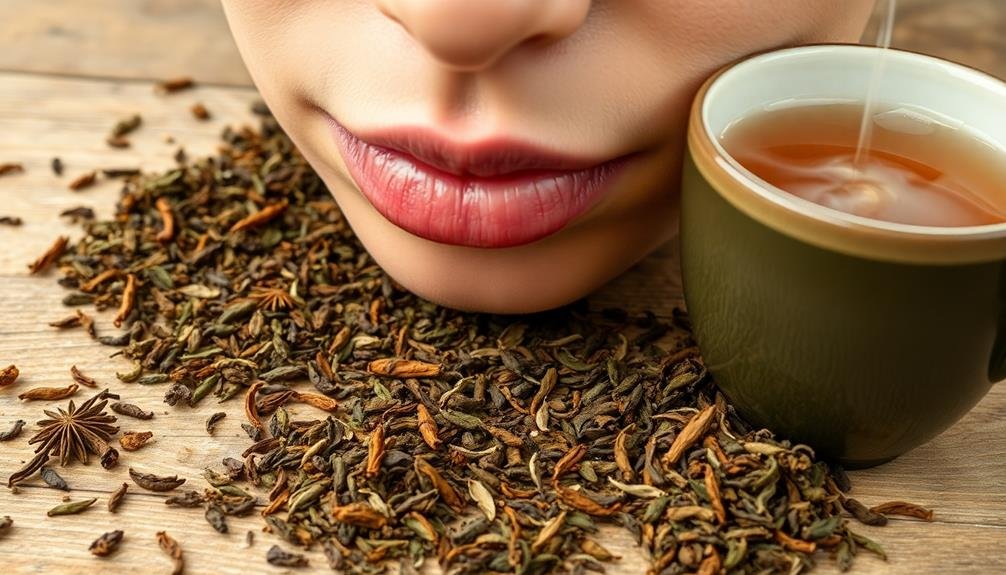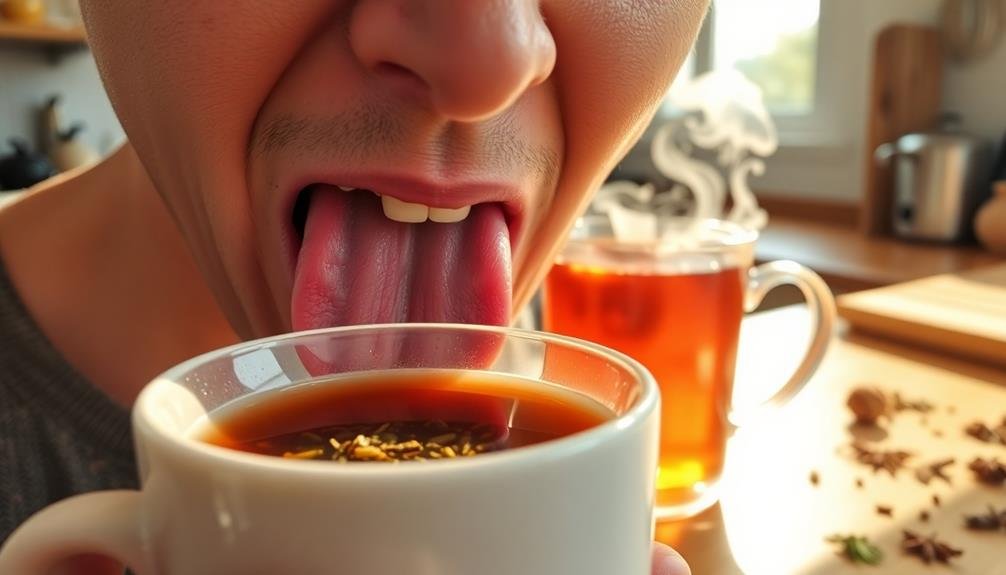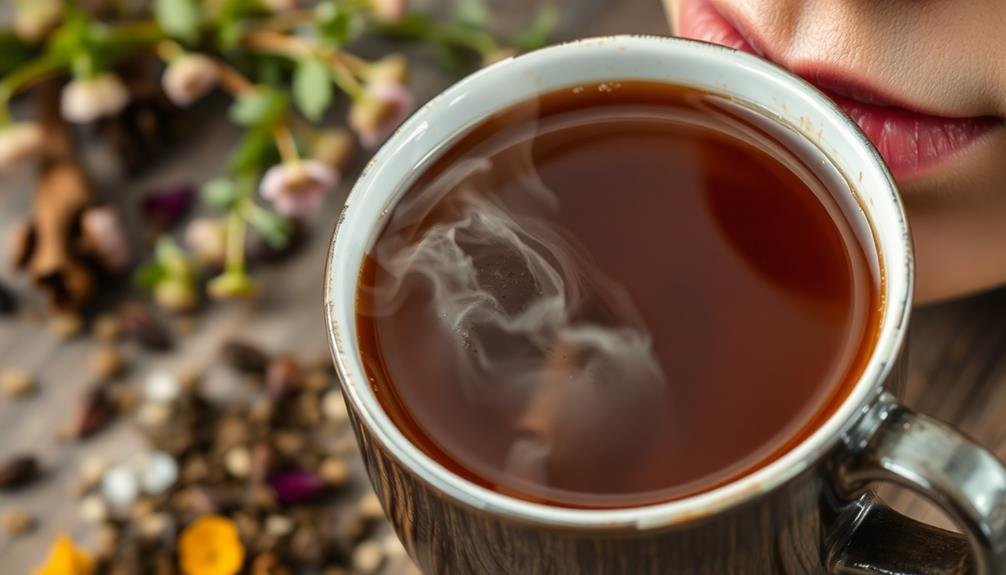To spot astringency in your herbal teas, start by observing the mouthfeel. You'll notice a drying or puckering sensation, similar to unripe fruit or strong red wine. Next, check for dryness on your tongue and palate. This can range from mild to intense, depending on the tea's composition. Finally, assess the aftertaste. Astringency often leaves a lingering dry, slightly bitter sensation that coats your tongue and can last for several minutes. By paying attention to these three aspects, you'll become adept at identifying and appreciating the astringent qualities in your favorite herbal brews. There's even more to discover about this fascinating tea characteristic.
Observe the Mouthfeel

How does astringency feel in your mouth? When you sip an astringent tea, you'll notice a distinctive sensation. It's often described as a drying or puckering effect, similar to what you might experience when eating unripe fruit or drinking strong red wine. This feeling is caused by the tannins in the tea interacting with the proteins in your saliva.
Pay attention to the texture of the tea as it coats your tongue and palate. Astringent teas can create a rough or grainy sensation, making your mouth feel less lubricated. You might also notice a slight tightening of your cheeks or gums. This effect can linger after you've swallowed the tea, sometimes leaving a slightly bitter aftertaste.
To truly observe the mouthfeel, take a small sip and let it sit on your tongue for a few seconds before swallowing. Roll the liquid around in your mouth, allowing it to touch all areas. This will help you identify where the astringency is most pronounced.
With practice, you'll become more adept at recognizing different levels of astringency in your herbal teas.
Check for Dryness
The dryness factor is a key indicator of astringency in herbal teas. When you sip an astringent tea, you'll notice a distinct drying sensation in your mouth, particularly on your tongue and palate. This feeling can range from mild to intense, depending on the tea's composition and brewing method.
To check for dryness, take a small sip of your herbal tea and let it linger in your mouth for a few seconds. Pay attention to how your mouth feels after swallowing. If you experience a parched sensation or a slight roughness on your tongue, you're likely dealing with an astringent tea.
Here's a quick guide to help you assess the dryness levels in your herbal tea:
| Dryness Level | Sensation | Common Herbs |
|---|---|---|
| Mild | Slight tightening | Chamomile, Lemon Balm |
| Moderate | Noticeable dryness | Green Tea, Hibiscus |
| Strong | Pronounced dryness | Black Tea, Sage |
| Intense | Puckering feeling | Oak Bark, Witch Hazel |
Remember that dryness isn't necessarily a negative quality. Many people enjoy the crisp, clean finish that astringency provides in their herbal teas. However, if you find the dryness overwhelming, try adjusting your brewing time or temperature to achieve a more balanced flavor profile.
Assess the Aftertaste

After you've sipped your herbal tea, pay close attention to the lingering sensations in your mouth. Astringency often reveals itself in the aftertaste, leaving a distinctive impression that can last for several minutes.
You'll notice a dry, puckering feeling that seems to coat your tongue and the inside of your cheeks. The aftertaste of an astringent tea is typically described as slightly bitter or tart, but it's more about the physical sensation than the flavor itself.
You might experience a slight roughness on your tongue or a feeling that your mouth is less lubricated than before. This sensation can intensify over time, reaching its peak a few moments after swallowing.
Pay attention to how long the aftertaste persists. Highly astringent teas will leave a lasting impression that can endure for several minutes.
If you find yourself repeatedly swallowing or reaching for water to alleviate the sensation, it's a strong indicator of astringency. Compare the aftertaste to other herbal teas you're familiar with to gauge the relative level of astringency and develop your palate for identifying this characteristic in various brews.
Frequently Asked Questions
What Causes Astringency in Herbal Teas?
Astringency in your herbal teas is caused by tannins, naturally occurring compounds in plants. You'll find them in many herbs and tea leaves. They're responsible for that dry, puckering sensation you feel in your mouth.
Can Astringency Be Reduced During the Brewing Process?
Yes, you can reduce astringency while brewing. Use cooler water, steep for less time, and add less tea. You'll also want to avoid over-steeping or crushing the leaves. These methods will help balance the tea's flavor.
Are There Health Benefits Associated With Astringent Teas?
Yes, astringent teas can offer health benefits. They're rich in antioxidants, which may boost your immune system and fight inflammation. You'll also find that they can help with digestion and may even promote oral health.
Which Herbal Teas Are Naturally More Astringent Than Others?
You'll find that certain herbal teas are naturally more astringent. Green tea, black tea, and white tea tend to be quite astringent. Herbals like raspberry leaf, blackberry leaf, and yarrow also pack a strong astringent punch.
How Does Astringency Differ From Bitterness in Taste?
You'll notice astringency as a drying, puckering sensation in your mouth, while bitterness is a sharp, unpleasant taste. Astringency affects your mouth's texture, whereas bitterness is purely a flavor you'll perceive on your tongue.
In Summary
You've now learned three key ways to identify astringency in your herbal teas. By observing the mouthfeel, checking for dryness, and evaluating the aftertaste, you'll be able to detect this distinct characteristic. Remember, astringency isn't always a negative trait; it's often an integral part of a tea's flavor profile. With practice, you'll become more adept at recognizing and appreciating astringency, enhancing your overall tea-drinking experience. Enjoy exploring the nuanced world of herbal teas!





Leave a Reply